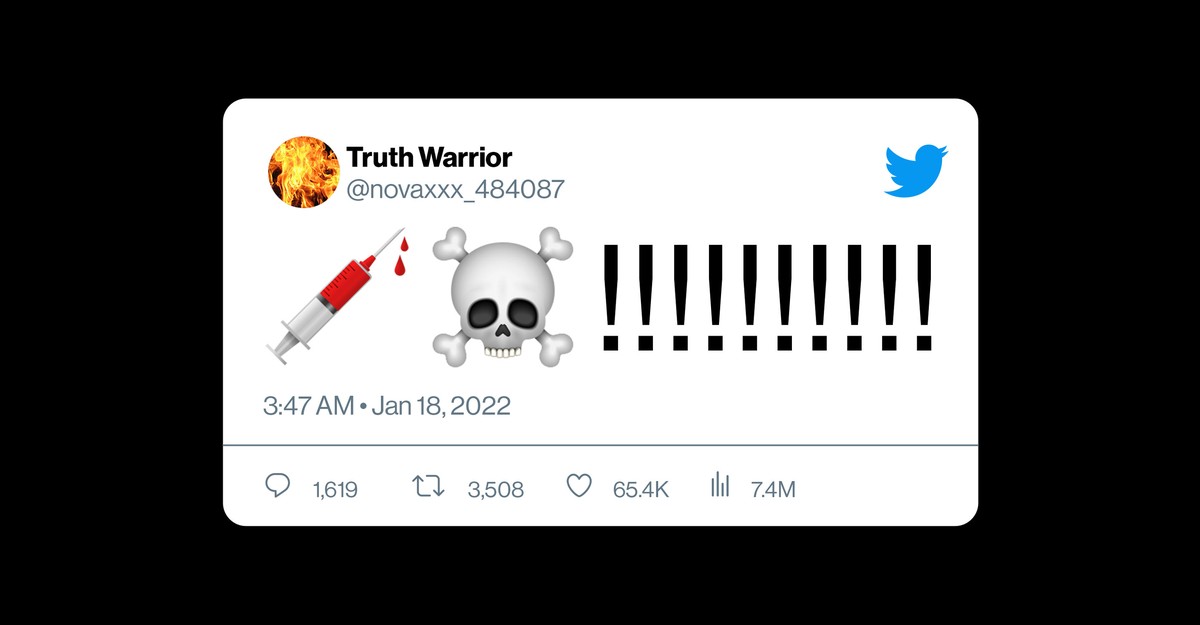The Sudden Rise of the ‘Died Suddenly’ COVID Conspiracy Theory

Lisa Marie Presley died unexpectedly earlier this month, and within hours, lacking any evidence, Twitter users were suggesting that her death had been caused by the COVID-19 vaccine.
The Twitter account @DiedSuddenly_, which has about 250,000 followers, also started tweeting about it immediately, using the hashtag #DiedSuddenly. Over the past several months, news stories about any kind of sudden death or grave injury—including the death of the sports journalist Grant Wahl and the sudden collapse of the Buffalo Bills safety Damar Hamlin—have been met with a similar reaction from anti-vaccine activists. Though most of the incidents had obvious explanations and almost certainly no connection to the vaccine, which has an extremely remote risk of causing heart inflammation—much smaller than the risk from COVID-19 itself—the idea that the shots are causing mass death has been boosted by right-wing media figures and a handful of well-known professional athletes.
They are supported by a recent video, Died Suddenly, that bills itself as “the documentary film of a generation.” The hour-long movie has spread unchecked on Rumble, a moderation-averse video-streaming platform, and Twitter, which abandoned its COVID-misinformation policy two days after the film premiered in November. It puts forth the familiar conspiracy theory that the vaccines were engineered as a form of population control, illustrated by stomach-turning footage of funeral directors and embalmers removing “white fibrous clots” that “look like calamari” from the corpses of people who have purportedly been vaccinated against COVID-19. (There are also some clips of Lee Harvey Oswald and the moon landing, for unclear reasons.)
Died Suddenly has been viewed nearly 20 million times and cheered on by far-right personalities such as Marjorie Taylor Greene and Candace Owens. It was released by the Stew Peters Network, whose other videos on Rumble have titles like “Obama Formed Shadow Government BEFORE Plandemic” and “AIRPORTS SHUT DOWN FOR EVERYONE BUT JEWS!” And its creators are already asking for donations to fund a sequel, Died Suddenly 2, which promises to explore “deeper rabbit holes.” (Nicholas Stumphauzer, one of the film’s directors, did not respond to questions, other than to say that the production team was motivated by a desire to “stop the globalist death cult.”)
As a meme, “died suddenly” could last a long time—possibly indefinitely. People will always be dying suddenly, so it will always be possible to redeploy it and capture further attention. What’s more, there is a thriving alt-tech ecosystem that can circulate the meme; a whole cohort of right-wing, anti-vaccine influencers and celebrities who can amplify it; and, crucially, a basically unmoderated mainstream social-media platform that can put it in front of hundreds of millions of users—some of whom will make fun of it, but others of whom will start to see something unsettling and credible in its repetitions.
What is most startling about the Died Suddenly documentary is not its argument, but the way that people are watching it. “#DiedSuddenly is the first movie to premiere on Twitter since your friendly takeover,” the official Died Suddenly account, @DiedSuddenly_, tweeted at Elon Musk. The account has a blue checkmark next to it—a symbol that used to indicate some kind of trustworthiness but now indicates a willingness to pay a monthly fee. When @DiedSuddenly_ first uploaded the movie in full on Twitter, it was labeled as misleading, in accordance with the COVID-19-misinformation policies that were then in place on the site. But this label was soon removed, on November 23, the same day that Twitter stopped enforcing rules about COVID-19 misinformation—including posts stating that the vaccines intentionally cause mass death.
Twitter, like many platforms, has spent the past decade refining its content-moderation policies. Now it is randomly throwing them out. Jing Zeng, a researcher at the University of Zurich, began her work on Twitter and conspiracy theories in 2018, and she noted a major transformation in response to the pandemic and the rise of QAnon. “Especially since the start of COVID, Twitter had been active in deplatforming conspiracy-theory-related accounts,” she told me. A lot of conspiracy theorists moved to fringe sites where they had trouble rebuilding the huge audiences they’d had on Twitter. But now their time in the desert may be over. “Twitter under Elon Musk has been giving signals to the communities of conspiracy theorists that Twitter’s door might be open to them again,” Zeng said.
The anti-vaccine movement is always poised to take advantage of such opportunities. Absent any moderation on Twitter, anti-vaxxers are once again free to experiment wildly with their messaging, according to Tamar Ginossar, a health-communication professor at the University of New Mexico who published a paper earlier in the pandemic about how vaccine-related content traveled on Twitter and YouTube. “Enough people are sharing this and enough content is being made that it’s taking off,” she told me.
In just a few months, the #DiedSuddenly meme has become a presence on most major social platforms, including Instagram and Facebook. At the end of 2022, researchers and reporters pointed to large Facebook groups dedicated to “Died Suddenly News.” Last week, I was able to join a community that was created in October and had more than 34,000 members. They referred to themselves as “pure bloods” and to vaccines as “cookies” or “cupcakes,” and alternated between mourning “sudden deaths” and gloating about them. And they had been careful to evade detection by Facebook’s automated content-moderation systems: Group administrators asked them to write about “de@ths and injury from the c0v1d sh0ts” and “disguise ALL words that have any medical meaning.” (Facebook removed the group after I inquired about it.)
But “died suddenly” thrives on Twitter. Tweets referencing news stories about unexpected deaths can be flooded with replies trumpeting the conspiracy theory, which go unmoderated. It’s a radical change from the earlier years of the pandemic, during which Twitter implemented new policies against health misinformation and updated them regularly, gradually finessing the wording and clarifying how the company assessed misleading information. These policies and the tactics used to enforce them tightened as the pandemic went on. According to a transparency report the company published in July 2022, Twitter suspended significantly more accounts and removed far more content during the vaccine rollout than during the earliest months of the pandemic, when various groups first expressed concern about dangerous misinformation spreading online.
This isn’t to say that Twitter’s policies were perfect. Journalists, politicians, and medical experts all had issues with how the site moderated content in the pandemic’s first two years. But from 2020 on, parties who were interested in the challenges of moderating health information were able to have a fairly nuanced debate about how well Twitter was doing with this super-convoluted task, and how it might improve. In 2020, a sea-change year for content moderation across the social web, major platforms were pushed by activists, politicians, and regular users to do more than they had ever done before. That year saw the proliferation of election disinformation and Donald Trump’s leadership of a violent, anti-democracy meme army, as well as nationwide protests in support of social justice whose reach extended to the practices of internet companies. And there was a backlash in response: Aggrieved right-wing influencers bemoaned the rise of censorship and the end of free speech; commentators with bad opinions about vaccines or other public-health measures got booted off Twitter and wound up on Substack, where they talked about getting booted off Twitter.
Now we’re in a reactionary moment in the history of content moderation. The alt-tech ecosystem expanded with the launch of Trump’s Truth Social and the return of Parler; the Died Suddenly filmmakers were recently interviewed for a program exclusive to Frank, the supposed free speech platform created by the MyPillow founder and conspiracy-theory promoter Mike Lindell. Some of the alt-tech platforms, including Rumble, saw significant growth by openly marketing themselves as anti-moderation. As I wrote at the end of last year, Rumble grew from 1 million monthly average users in 2020 to 36 million in the third quarter of 2021. The platform used to market itself as a “clean” alternative to YouTube, but its CEO now talks about its aversion to “cancel culture” and its goal of “restoring” the internet “to its roots” by eliminating content guidelines.
And Twitter is backsliding, led by a CEO who has delighted in sharing company documents with critics who held the old COVID-19 policies in disdain. In the “Died Suddenly” Facebook group I joined, commenters praised Musk’s version of the site. “Sign up for Twitter,” one wrote. Those questioning the vaccines used to be “censored earlier by the old Twitter nazis,” but now there is “FREE SPEECH.” “If you want TRUE information … get off Facebook and get on Twitter,” another posted before the group was shut down.
Earlier in the pandemic, researchers like Zeng were concerned about “dark platforms” such as 8kun or Gab, and how their wacky, dangerous ideas about COVID-19 could leech onto mainstream platforms. But now? The difference between alt and mainstream is getting slimmer.
This article has been archived for your research. The original version from The Atlantic can be found here.


